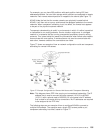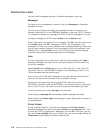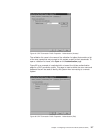
If you wish to narrow your search and do not wish to see all QTCP jobs, you can
specify AS/400 job name on the Include dialog. The job name consists of three
parts: Job number, Job user, and Job name.
Optional Monitoring of Point-to-Point Activity
An optional method to monitor activity for Point-to-Point connection profiles is to
invoke option 14 from the Work with Point-to-Point TCP/IP (WRKTCPPTP)
command on a 5250 AS/400 console. For more information about this option, see
“Monitoring Point-to-Point Activity” on page 134.
Connection Alternatives
This section provides you an overview of the link layer connection alternatives
available to you.
Point-to-point links establish a physical connection between a local and remote
host. When connected, these links provide dedicated bandwidth and come in a
variety of data rates and protocols. With point-to-point links, you can choose from
dial-up analog modem connections, leased analog lines, and switched and leased
digital services of various kinds.
PPP is a method of transmitting datagrams over serial point-to-point links. PPP
enables interconnection of multiple vendor equipment and multiple protocols by
standardizing point-to-point communications. The PPP data link layer uses
HDLC-like framing for encapsulating datagrams over both asynchronous and
synchronous point-to-point telecommunication links.
While PPP supports a wide range of link types, SLIP is limited to asynchronous link
types. SLIP is generally employed only for analog links.
Local telephone companies offer traditional telecommunications services in an
ascending scale of capabilities and cost. These services use existing telephone
company voice network facilities between customer and central office. A comparison
of communication services and their relative costs is shown in Table 8. The costs
shown are not intended to reflect current pricing. Instead, they are intended to
show relative differences between services. Cost rates on leased lines are usually
distance-based, while the switched lines may also be time-based.
Note: The following table is for illustration purposes only. It does not include all
supported AS/400 configurations. The costs shown are not intended to reflect
current pricing.
Table 8. Comparison of communication services and relative costs
Service Line Speed
Required
Equipment
DTE/DCE
Interface
Relative Cost
(per month)
Analog (leased
and switched)
33.4Kbps or less Modem
RS232
asynchronous
$20-$150
Digital Data
Service (DDS)
56.0Kbps or less CSU/DSU
X.21/V.35/RS-
449 synchronous
$50-$500
Switched-56 56.0Kbps
CSU/DSU with
V.25bis dial
V.35/RS-449
synchronous
$50-$250
Chapter 4. Configuring Point-to-Point TCP/IP (PPP and SLIP) 111


















